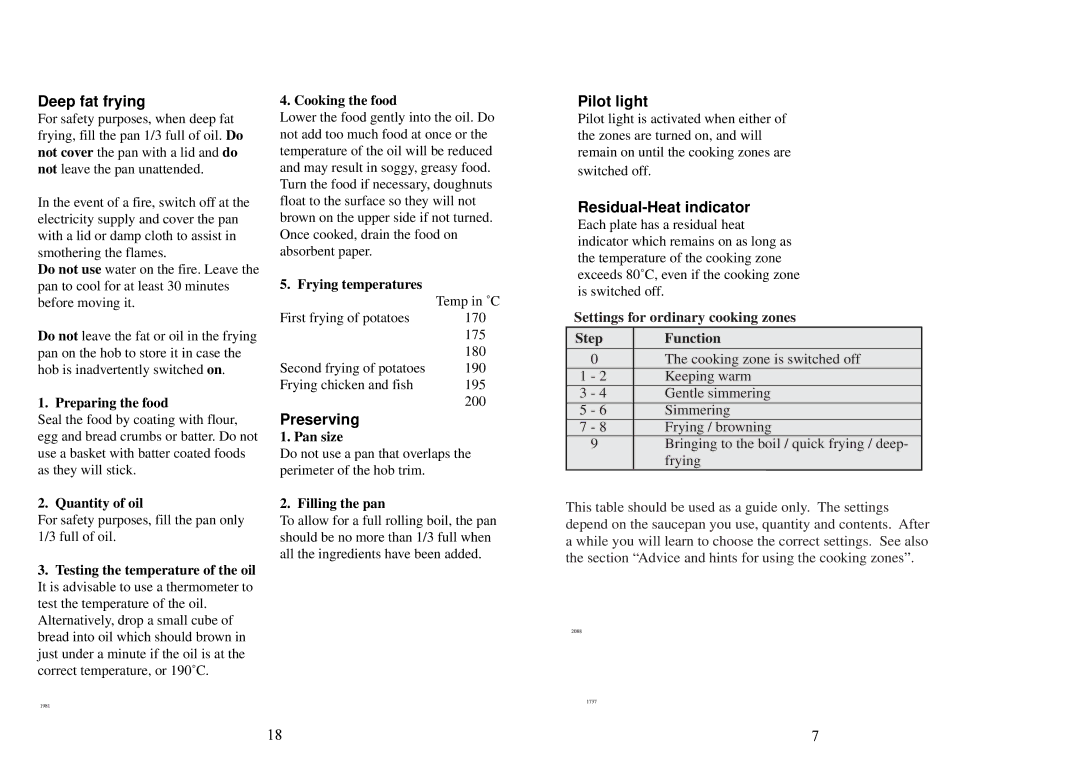
Deep fat frying
For safety purposes, when deep fat frying, fill the pan 1/3 full of oil. Do not cover the pan with a lid and do not leave the pan unattended.
In the event of a fire, switch off at the electricity supply and cover the pan with a lid or damp cloth to assist in smothering the flames.
Do not use water on the fire. Leave the pan to cool for at least 30 minutes before moving it.
Do not leave the fat or oil in the frying pan on the hob to store it in case the hob is inadvertently switched on.
1. Preparing the food
Seal the food by coating with flour, egg and bread crumbs or batter. Do not use a basket with batter coated foods as they will stick.
2. Quantity of oil
For safety purposes, fill the pan only 1/3 full of oil.
3.Testing the temperature of the oil It is advisable to use a thermometer to test the temperature of the oil.
Alternatively, drop a small cube of bread into oil which should brown in just under a minute if the oil is at the correct temperature, or 190˚C.
4. Cooking the food
Lower the food gently into the oil. Do not add too much food at once or the temperature of the oil will be reduced and may result in soggy, greasy food. Turn the food if necessary, doughnuts float to the surface so they will not brown on the upper side if not turned. Once cooked, drain the food on absorbent paper.
5. Frying temperatures |
|
| Temp in ˚C |
First frying of potatoes | 170 |
| 175 |
| 180 |
Second frying of potatoes | 190 |
Frying chicken and fish | 195 |
| 200 |
Preserving
1. Pan size
Do not use a pan that overlaps the perimeter of the hob trim.
2. Filling the pan
To allow for a full rolling boil, the pan should be no more than 1/3 full when all the ingredients have been added.
Pilot light
Pilot light is activated when either of the zones are turned on, and will remain on until the cooking zones are switched off.
Residual-Heat indicator
Each plate has a residual heat indicator which remains on as long as the temperature of the cooking zone exceeds 80˚C, even if the cooking zone is switched off.
Settings for ordinary cooking zones
Step | Function | |||
|
|
| ||
| 0 | The cooking zone is switched off | ||
1 | - 2 | Keeping warm | ||
3 | - 4 | Gentle simmering |
| |
5 | - 6 | Simmering | ||
7 | - 8 | Frying / browning |
| |
| 9 | Bringing to the boil / quick frying / deep- |
| |
|
| frying | ||
This table should be used as a guide only. The settings depend on the saucepan you use, quantity and contents. After a while you will learn to choose the correct settings. See also the section “Advice and hints for using the cooking zones”.
18 | 7 |
